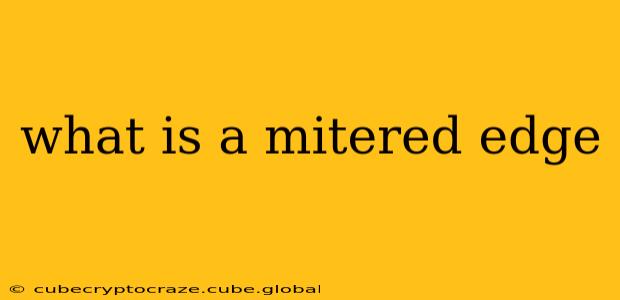A mitered edge is a type of angled cut, typically used to join two pieces of material at a 45-degree angle. This creates a seamless, visually appealing joint that is stronger and more aesthetically pleasing than a simple butt joint. The precise angle of the cut is crucial for a perfect fit, and the resulting edge often resembles a sharp, angled point, hence the term "miter." This technique finds applications across various fields, from woodworking and picture framing to metalwork and even sewing.
What Makes a Mitered Edge Different?
Unlike a butt joint (where two pieces meet at a 90-degree angle), a mitered edge involves angling both pieces to achieve a smooth, almost invisible join. This angled cut forms a 45-degree angle on each piece, which when joined, creates a nearly seamless 90-degree angle. The precision of the cut is key; any discrepancy will result in a gap or an uneven joint.
This difference is not just aesthetic. Mitered joints, when done correctly, are significantly stronger than butt joints, especially when reinforced with additional methods like glue or dowels. The increased surface area of contact between the angled pieces contributes to their superior strength and stability.
Types of Mitered Joints
While the most common mitered joint is the 45-degree angle for creating a 90-degree corner, variations exist depending on the desired outcome and the material being used:
- Standard 45-degree miter: This is the most common type, used for joining two pieces at a 90-degree angle.
- Double miter: Used for joining four pieces to form a square frame, often seen in picture frames and boxes. Each piece is cut at a 45-degree angle.
- Compound miter: This type involves angles other than 45 degrees, often used for joining pieces at angles other than 90 degrees. This is more complex and requires careful planning and precise cutting.
- Mitered box joint: A more advanced technique combining the strength of a box joint with the clean lines of a mitered joint. This is a very strong and visually appealing joint.
How is a Mitered Edge Created?
Creating a perfect mitered edge requires precision tools and techniques. The most common tools used include:
- Miter saw: This power tool is specifically designed for accurate angled cuts.
- Hand saw: With practice, a sharp hand saw can produce accurate miter cuts, but it requires more skill and patience.
- Miter box: A simple jig that guides a hand saw to ensure accurate angled cuts.
- Measuring tools: Accurate measurement is crucial for a perfect miter joint.
Regardless of the tool used, accurate measurement and careful execution are vital for a successful miter joint. A slight inaccuracy in the angle can result in a noticeable gap.
What are the Advantages of Using a Mitered Edge?
The popularity of mitered edges stems from several significant advantages:
- Aesthetic Appeal: The clean, seamless look of a properly executed mitered joint enhances the overall appearance of a project.
- Strength: Mitered joints offer greater strength compared to simple butt joints, particularly when reinforced with glue or other fasteners.
- Versatility: Mitered joints can be used in various materials and projects, from simple frames to intricate furniture.
What are Some Common Applications of Mitered Edges?
Mitered edges find application in various fields:
- Woodworking: Picture frames, boxes, crown molding, furniture components.
- Metalwork: Joining metal sheets or pipes.
- Sewing: Creating angled seams in garments.
- Construction: Joining trim pieces.
What Materials are Commonly Used with Mitered Edges?
Mitered edges are commonly used with:
- Wood: Various types of wood, from softwoods to hardwoods.
- Metal: Aluminum, steel, brass.
- Plastics: Acrylic, PVC.
- Fabric: In specialized sewing applications.
How to Fix a Miter Joint That Doesn't Fit Properly?
If a miter joint doesn't fit perfectly, it is usually due to inaccurate cuts. Slight inaccuracies can often be corrected with wood filler or caulk. Larger gaps may require re-cutting the pieces. For wood, a slight sanding might also help achieve a better fit before gluing.
This comprehensive guide details what a mitered edge is, its advantages, applications, and how it's created. Remember, precision is key to achieving a perfect mitered joint.
